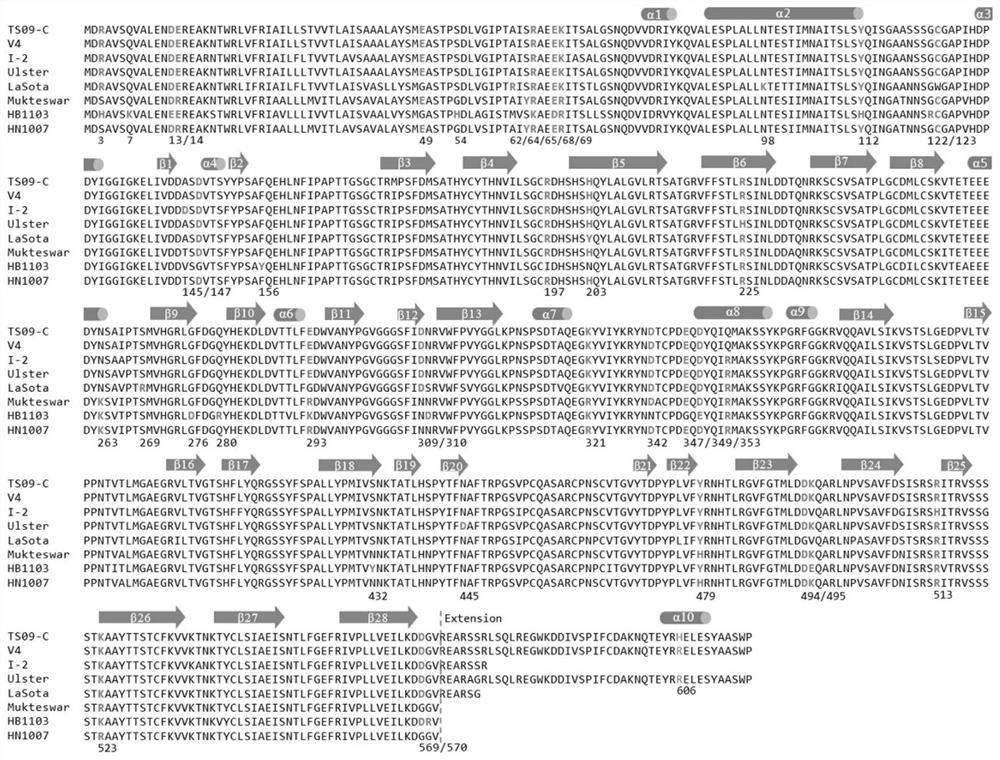Genetic modification method for changing thermal stability of envelope virus, recombinant virus and application of recombinant virus
A technology of genetic modification and thermal stability, applied in the field of molecular biology technology and microbiology, can solve the problems such as the thermal stability relationship of unknown viruses, and achieve the effects of weakening viability, reducing cost and reducing virulence
- Summary
- Abstract
- Description
- Claims
- Application Information
AI Technical Summary
Problems solved by technology
Method used
Image
Examples
Embodiment 1
[0038] This embodiment provides a genetic modification method for improving the thermal stability of Newcastle disease virus, comprising the following steps:
[0039] S101:
[0040] Compare the HN protein amino acid sequences of 3 heat-resistant strains of Newcastle disease virus, 4 non-heat-resistant strains and the virus strain TS09-C to be transformed; the 3 heat-resistant strains are V4, I-2, Ulster strain, and the The 4 non-heat resistant strains are LaSota, Mukteswwar, HB1103, HN1107 strains;
[0041] Such as figure 1 As shown, the 3 heat-resistant strains and the 4 non-heat-resistant strains have a total of 85 sites with amino acid mutations compared with the same sites of the TS09-C strain. However, because the mutations at 42 of the 85 sites in the heat-resistant strain and the non-heat-resistant strain will not change the charge value of the adsorbed protein, they are excluded, and only the remaining N is 43 mutations that will affect the charge of the HN protein. ...
Embodiment 2
[0067] Such as Figure 4 As shown, this example is roughly the same as Example 1, except that the other four sites of the 10 amino acid mutation sites in step S103 are selected to obtain two different mutation schemes, and the mutations constructed and rescued using the same method Viruses rTS-HN-UN4 and rTS-HN-PU4. At the same time, the other four sites of the 19 amino acid mutation sites in step S103 were selected to obtain two different mutation schemes, using the same method to construct and rescue mutant viruses rTS-HN-UP4 and rTS-HN-NU4. The mutation method of rTS-HN-UN4 is that all four sites are mutated from uncharged amino acids to negatively charged amino acids, and the mutation method of rTS-HN-PU4 is that all four sites are mutated from positively charged amino acids to uncharged amino acids. In addition, the mutation method of rTS-HN-UP4 is that all four sites are mutated from uncharged amino acids to positively charged amino acids, while the mutation method of r...
Embodiment 3
[0069] Heat-resistant Transformation of Newcastle Disease Virus LaSota Strain
[0070] Newcastle disease virus LaSota strain, as a classic strain for the preparation of low-virulence live vaccines, has been widely promoted and applied worldwide, making important contributions to the prevention and control of Newcastle disease. However, due to the poor thermal stability of this strain, it is a non-heat-resistant strain. Therefore, live vaccines prepared from this strain need to be stored and transported in a cold chain system, which increases the cost of immunization and the risk of vaccine failure. Apply the method of the present invention to carry out heat resistance transformation and effect test on LaSota strain.
[0071] According to the same method of embodiment 1, compare the HN protein amino acids of 4 strains of Newcastle disease virus heat-resistant strains, 3 strains of non-heat-resistant strains and the virus LaSota strain to be transformed; the 4 strains of heat-re...
PUM
 Login to View More
Login to View More Abstract
Description
Claims
Application Information
 Login to View More
Login to View More - R&D
- Intellectual Property
- Life Sciences
- Materials
- Tech Scout
- Unparalleled Data Quality
- Higher Quality Content
- 60% Fewer Hallucinations
Browse by: Latest US Patents, China's latest patents, Technical Efficacy Thesaurus, Application Domain, Technology Topic, Popular Technical Reports.
© 2025 PatSnap. All rights reserved.Legal|Privacy policy|Modern Slavery Act Transparency Statement|Sitemap|About US| Contact US: help@patsnap.com



